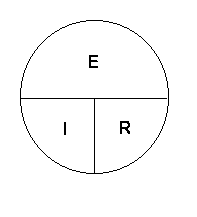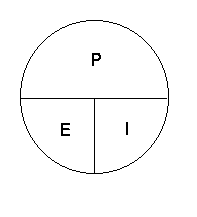| THE
CALCULATIONS PAGE There are a few calculations that you should practice and have memorized for the purpose of the test. With some you'll have to know how to work with them. With others, you must only be familiar with the concepts. Be prepared to convert units in most all of them. UNIT CONVERSIONS Microfarads. Milliamps. Centimeters. Gigahertz. Just about all units of measurement in ham radio are in metric terms. Get used to it, if you're not already, because everybody in the world, with the exception of the general U.S. population, is already there. Actually, working in metric is easy. Basic intermetric units are converted by changing prefixes which either lower or raise the value of the base unit by a factor of ten. Let's take the meter, for example. Let's change the a meter into centimeter units. "Centi" equates to "1/100." A centimeter is 1/100th of a meter, therefore, there are 100 centimeters in a meter. Look at the table below to see the commonly used prefixes:
Practice: 1) What is 1.23 megahertz in terms of gigahertz? Here, we are moving up in term term value. "Mega" is separated by "giga" by a factor of three. Move the decimal point to the left three places to get the answer. You will have to add zeros. Answer: 0.00123 GHz 2) What is 33.0 amps in terms of milliamps? Here, you are scaling down in terms. "Milli" is separated by the base unit again by a factor of three, except now we are moving in the other direction. To convert, move the decimal place to the right three places. Answer: 33,000 milliamps FREQUENCY / WAVELENGTH DETERMINATION If given a frequency in hertz, you will need to be able to convert it to its wavelength equivalent in meters. The formulas will yield approximate values. Wavelength (in meters) = 300 / frequency (in MHz) Conversely, you might have to swap terms and change wavelength into frequency. Frequency = 300 / Wavelength OHM'S LAW AND POWER CALCULATION Remember these equations from the basic electronics page? E = I x R P = E x I Here again are the "magic circles" to help you remember. Look out for unit conversions in these questions.
TOTAL RESISTANCE AND INDUCTANCE The formulas for calculating total resistance and inductance are very similiar. First, let's look at resistance: For resistors in series, it's just simple addition of resistance values: R(total) = R1 + R2 + R3 + . . R n For two resistors in parallel: R(total) = (R1 x R2) / (R1 + R2) For more than two resistors in parallel: R(total) = 1 / (1/R1) + (1/R2) + (1/R3) + . . . (1/R n) Notice that for resistors in parallel arrangement, the total resistance is less than the resistor with the lowest value. *** Note: The term "n" indicates an infinite addition of other components ***
Inductance formulas follow the exact same pattern: For inductors in series: L (total) = L1 + L2 + L3 + . . L n For two inductors in parallel: L (total) = (L1 x L2) / (L1 + L2) For more than two inductors in parallel: L (total) = 1 / (1/L1) + (1/L2) + (1/L3) + . . . (1/L n) For inductors in parallel, the total inductance is less than the inductor with the lowest value.
TOTAL CAPACITANCE Capacitance formulas are similiar, but backwards: For two capacitors in series: C (total) = (C1 x C2) / (C1 + C2) For more than two capacitors in series: C (total) = 1 / (1/C1) + (1/C2) + (1/C3) + . . . (1/C n) For resistors in parallel: C (total) = C1 + C2 + C3 + . . C n For capacitors in series, the total capacitance is less than the capacitor with the lowest value. TOTAL ANTENNA POWER OUTPUT To determine the total power output of an antenna, us this equation: Total Power = Foward Power - Reflected Power CALCULATING ANTENNA LENGTH AND RESONANT FREQUENCY Half-wavelength dipole antenna length (in feet) = 468 / operating frequency in MHz Quarter-wavelength vertical antenna length (in feet) = 234 / operating frequency in MHz Operating frequency of a specific half-wavelength dipole antenna (in MHz) = 468 / antenna length (in feet) Operating frequency of a specific quarter-wavelength dipole antenna (in MHz) = 234 / antenna length (in feet) NEAR FIELD AND FAR FIELD CALCULATIONS Because the near field boundary is highly dependant on antenna type, it is difficult to accurately evaluate the effects of radiation exposure. Generally speaking, the dimensions of the near field can be defined by multiplying the square of the antenna length by 2 and then dividing by the wavelength of the signal. In the far field, exposure diminishes by distance with the inverse square law: the power density is proportional to the inverse square of the distance. There is an relationship for equating the electrical field with the magnetic field in the far field region. 377 ohms = E (the electric field in volts/meter) / H (the magnetic field in amps/meter)
|


